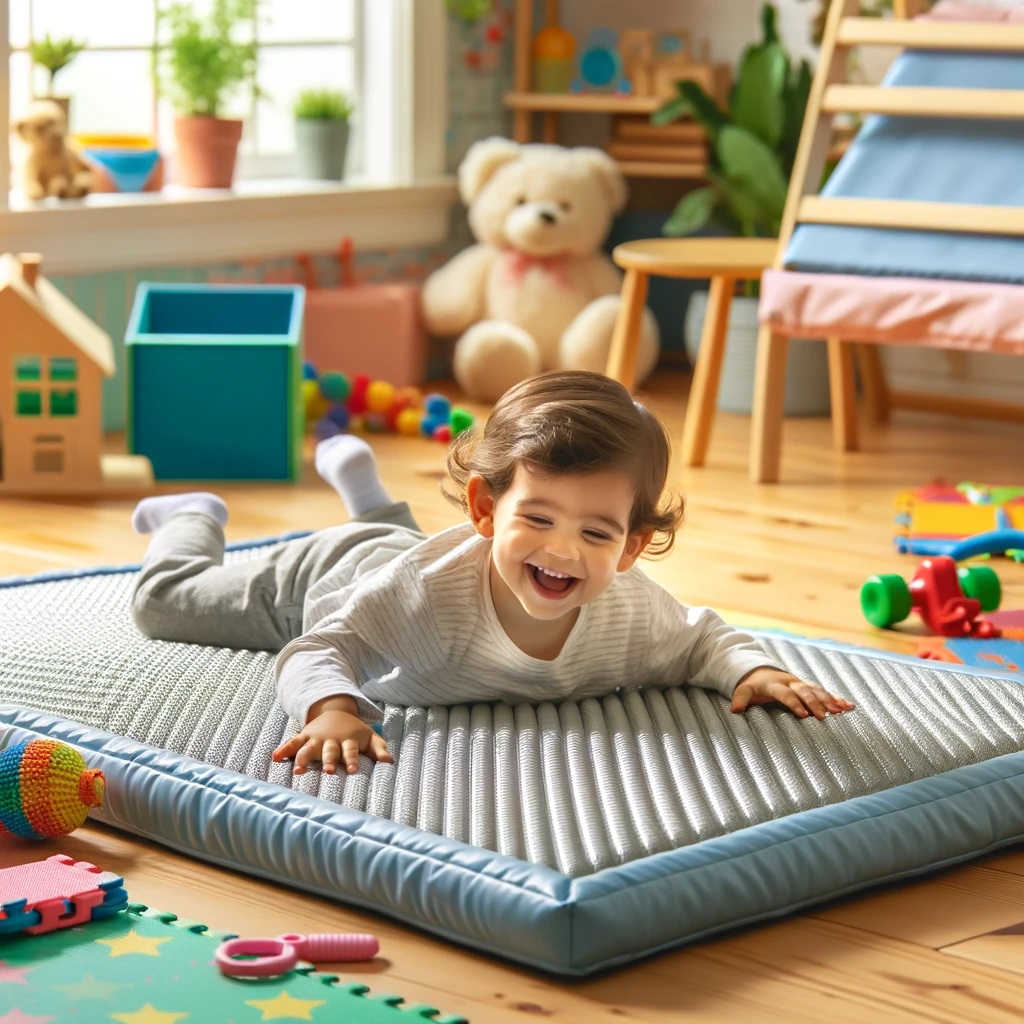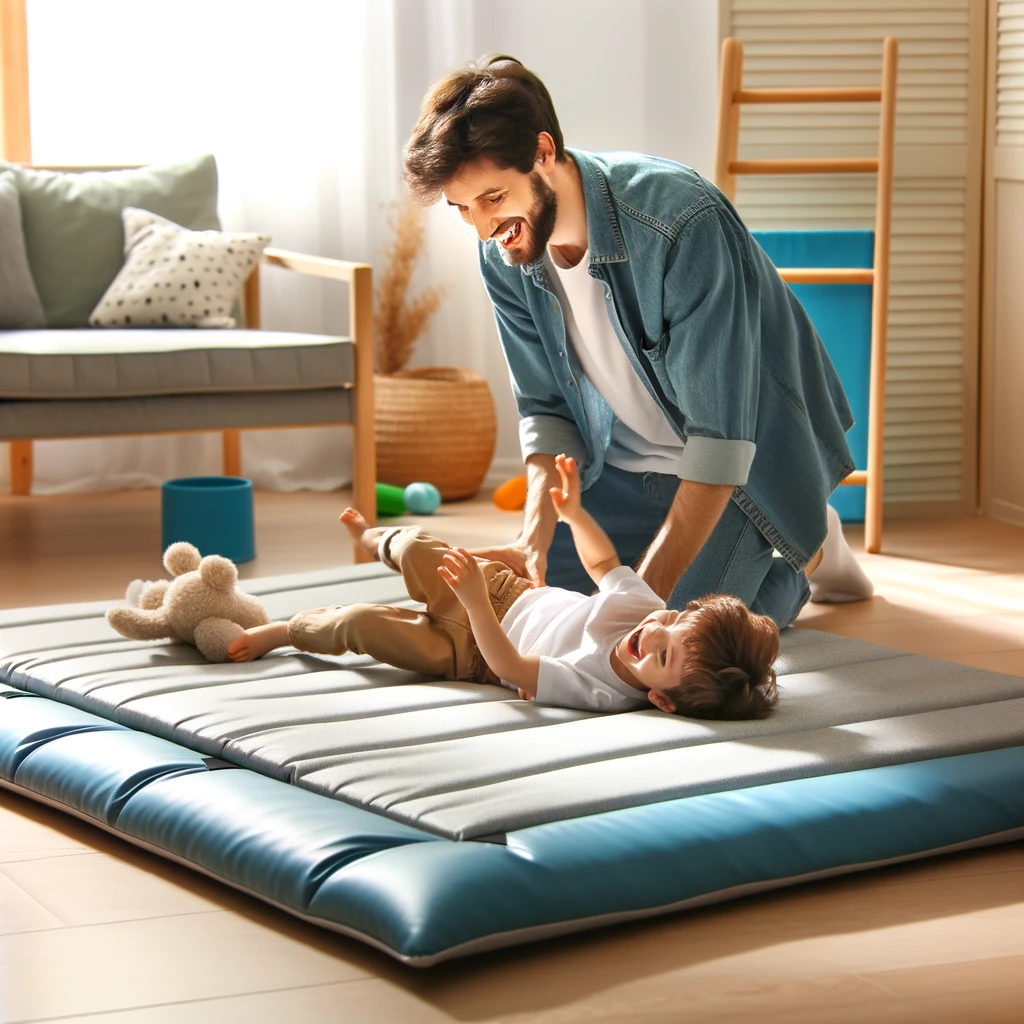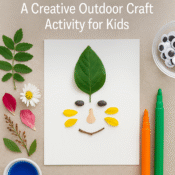
Crafting Crash Pads to Improve Sensory Integration Skills
As a parent, you know that helping your child develop their sensory integration skills is crucial for their development. Creating a sensory crash mat at home can be an engaging way to support your child’s sensory needs. In this article, you’ll learn how to make a budget-friendly crash mat using basic materials like foam blocks and a futon cover. We’ll walk through the process of calculating the right foam size, finding affordable materials locally or online, and assembling it all to create a soft, deep crash mat. You’ll finish this project not only with a valuable therapeutic tool for your child, but also with a sense of accomplishment at having created something with your own hands. Follow along as we break down this creative project step-by-step. With a little effort, you can build an impactful sensory integration aid that will bring joy and comfort to your child.
What Is a Sensory Crash Mat?
A sensory crash mat is a crash mat that can be used like a bean bag to increase sensory input and help develop proprioceptive awareness. Proprioception refers to our body’s ability to sense the position, location, orientation, and movement of our limbs and trunk. A crash mat provides deep pressure to help calm the nervous system and organise sensory information.
Materials Needed
To make a basic crash mat, you will need:
- A large futon cover or bean bag cover
- Foam blocks
For the foam blocks, choose a medium density foam that is at least 6 inches thick. Have the foam cut into cubes that measure 6 inches by 6 inches. You will need around 80 cubes for a standard sized crash mat. The exact number will depend on the size of your cover.
Why Use a Sensory Crash Mat?
A crash mat can be beneficial for both children and adults with sensory processing difficulties. The deep pressure and proprioceptive input from the foam blocks helps to calm the nervous system and improve body awareness. Regular use of a crash mat has been shown to decrease overreaction to sensations and improve coordination and balance over time.
For children, a crash mat can provide a safe space for rough play and tumbling. The foam blocks cushion falls and impacts so children can freely explore movement without fear of injury. This type of sensory play is important for development and can help build stronger neural connections in the brain.

How to Use a Sensory Crash Mat
A crash mat can be used in a variety of ways:
- Sitting or lying on the mat provides deep pressure to the whole body.
- Rolling, tumbling and rough play on the mat helps to stimulate the proprioceptive system in a fun, engaging way.
- Having a child do an obstacle course over and around the mat challenges balance and coordination.
- Throwing foam blocks at the mat and having the child catch or dodge them improves motor planning and reaction times.
- Doing yoga or exercises on the mat enhances body awareness and flexibility.
With regular use, a sensory crash mat can be an effective therapeutic tool for improving sensory processing and motor skills. Be creative and have fun with different activities on the mat!
Why Use a Sensory Crash Mat?
A sensory crash mat provides proprioceptive input through deep pressure to help regulate the body’s nervous system. For children with sensory processing difficulties, a crash mat can be an important tool for developing body awareness and learning to modulate reactions to sensations.
Proprioception and Body Awareness
Proprioception refers to the body’s sense of itself in space. It encompasses awareness of body position and movement, as well as the amount of force needed for motor control. For most children, proprioceptive processing develops naturally. However, for some, the messages from proprioceptive receptors are disorganised or misinterpreted.
A crash mat applies deep pressure to the joints and muscles as a child plays, rolls and crashes on it. This stimulates proprioceptors in the body that feed information to the brain about body position and movement. Repeated use helps to improve neural connections involved in proprioception and body awareness.
Regulating Reactions
For children with sensory processing difficulties, sensations are often perceived as irritating, threatening or uncomfortable. Their reactions tend to be disproportionate as the nervous system struggles to modulate input appropriately. Activities like rolling, crashing and wrestling on a crash mat provide intensive sensory experiences in a controlled way. This helps to desensitise the nervous system over time and build tolerance for sensations through repeated exposure.
A crash mat is a useful therapeutic tool that can enhance sensory processing, body awareness and modulation of reactions to input. With regular use, a child may gain a better sense of body position in space, develop appropriate responses to sensations, and improve skills like balance, coordination and motor planning. For children with sensory challenges, a crash mat can be an important aid for developing these critical abilities.

Understanding Proprioception and Sensory Processing
The Role of Proprioception
Proprioception refers to the sense that detects the position and movement of the body. It arises from sensors in the joints, muscles, tendons, and inner ear, which send signals to the brain about the body’s position in space. For most individuals, this sense develops normally in infancy and early childhood. However, for those with sensory processing difficulties, the proprioceptive sense may be under- or over-developed, making it challenging to interpret the signals from one’s body and the surrounding environment.
Sensory Processing Disorder and Its Impact
Sensory processing disorder, also known as sensory integration dysfunction, occurs when the brain has trouble organising and responding to sensory input appropriately. Individuals with this disorder may be over- or under-reactive to sensory stimulation. They may have trouble with balance and coordination, experiencing sensations of falling or dizziness. Difficulty processing proprioceptive input can make ordinary physical contact feel threatening and lead to distressed behavioural reactions. Providing opportunities for proprioceptive stimulation, such as with a sensory crash mat, helps address this underlying difficulty.
Benefits of Proprioceptive Input
Proprioceptive input, such as deep pressure, helps calm the nervous system and organise sensory information. Activities like crawling, climbing, pushing, pulling, and squeezing provide proprioceptive stimulation. A sensory crash mat filled with foam blocks allows individuals to jump, roll, burrow, and crash into the mat. This helps meet the need for proprioceptive input in a fun, engaging way. Over time, regular use of a crash mat can help decrease overreaction to sensations and improve sensory processing, balance, and body awareness.
In summary, proprioception plays an important role in sensory processing and development. Difficulties in this area can significantly impact behaviour, coordination, and daily functioning. Providing opportunities for proprioceptive stimulation, such as with the use of a sensory crash mat, helps address these challenges in an enjoyable, therapeutic manner. With regular use, a crash mat can support improved sensory integration and more appropriate reactions to sensations.
How to Make Your Own Sensory Crash Mat
A sensory crash mat requires careful consideration of materials and construction to meet the needs of an individual. The primary goals are to create a padded surface large enough for the user to lay or fall onto without risk of injury.
Foam Blocks
Purchase foam blocks of medium density and cut them to size for the desired depth of the crash mat. For most adults and children, aim for 6-8 inches in depth. Seek out a local foam retailer to have the blocks cut to size to save on shipping costs. Standard foam types for crash mats include polyurethane and polyethylene.
Futon Cover
A futon cover or slip cover in a durable, washable material like denim or canvas encases the foam blocks. Select a cover at least 2 feet longer and wider than the dimensions of the foam base. For ease of construction, choose a cover that zips or buttons closed on three sides. The open end will allow the insertion of the foam blocks.
Construction
With the futon cover laid open, begin stacking the foam blocks inside, staggering the layers for maximum stability. Work from the bottom up, adding one layer at a time. Once the desired depth is reached, fold the open end of the cover closed and secure tightly to contain the foam blocks. For larger crash mats, you may need an additional person to help manoeuvre and stack the foam.

Uses
A sensory crash mat provides a safe space for proprioceptive input. Individuals can jump, crash, roll and bounce on the mat to stimulate their senses. The pliable surface and depth of the mat protects from injury while providing sensory feedback. Occupational therapists often recommend the use of crash mats, trampolines and other equipment for sensory integration therapy at home. With regular use, a sensory crash mat can help decrease overreactions to sensations and improve body awareness and motor control.
By following these steps carefully, you can construct an effective sensory crash mat to meet a range of needs. The materials and construction allow for customization of size, depth and washability. With the proper use and precautions, a sensory crash mat provides opportunities for therapeutic sensory stimulation within the home environment.
Choosing the Right Size and Fill Material
The size and fill material of the sensory crash mat are crucial factors to consider for optimal therapeutic benefits. The crash mat should be large enough to fully contain an average-sized adult in a reclined position, with additional space on all sides. For most individuals, a minimum size of 4 to 6 feet in width and 6 to 8 feet in length is recommended to provide adequate surface area.
Crash pad fill material, such as foam blocks or bean bag filler, should be selected based on the desired firmness and density. Softer, less dense fills provide minimal resistance and impact absorption for gentle sensory stimulation. Denser fills offer more resistance for proprioceptive input, while still cushioning the body. Polyurethane foam, microbeads and shredded foam are common fill choices.
Foam Blocks
Polyurethane foam blocks in 6 to 8 inch thickness provide firm, supportive cushioning for crash mats. Foam density is measured in pounds per cubic foot (PCF), with higher densities indicating greater firmness. A density of 2 to 3 PCF is moderately firm, suitable for most sensory needs. Foam blocks can be cut to size to achieve the desired depth and contouring within the crash mat. They provide consistent, reliable fill that retains shape well over time. However, foam blocks may be more expensive and can lack pliability compared to other options.
Microbeads
Microbead fill consists of tiny polystyrene beads, approximately 1mm in size, encased in a breathable liner within the crash mat. Microbeads offer a bean bag-like feel that contours closely to the body. They provide dynamic proprioceptive input as the beads shift with movement. However, microbeads tend to compress over time and with frequent use, requiring occasional re-fluffing to maintain shape. They may not provide as much support as foam for some individuals.
Shredded Foam
Shredded foam fill contains irregular chunks of polyurethane foam, ranging from 1 to 6 inches in size, giving it a lumpy, uneven texture. Like microbeads, shredded foam contours closely to the body but also compresses over time. It tends to provide slightly more support than microbeads due to the larger size of the foam pieces. Shredded foam fill may require re-fluffing to prevent unevenness and maintain adequate depth. Its irregular shape can make it more difficult to gauge the amount needed to fill a given space.
In summary, the ideal sensory crash mat and fill material depends on the specific therapeutic goals and needs of the individual. A balance of size, firmness and pliability should be considered to provide dynamic, responsive proprioceptive input within a supportive space. The fill material may require occasional maintenance to retain shape, but should provide long-term durability and functionality.
Step-by-Step Instructions to Assemble Your Crash Mat
Procurement of Materials
The first step is to obtain the necessary components to construct the crash mat. You will require an inexpensive yet durable futon cover or bean bag casing and polyethylene foam cubes. Visit a local foam retailer to purchase medium density foam cubes measuring six inches in height, width and depth. For a standard sized crash mat, acquire approximately 80 to 100 foam cubes. Alternatively, you may purchase the materials online if local retailers are not available. However, purchasing in person is ideal as it allows you to inspect the quality and density of the materials.
Fitting the Foam Cubes
Once you have obtained the necessary materials, proceed to stuff the futon cover or bean bag casing with the foam cubes. Ensure the covering is securely closed or sealed on one end before filling. Gently place one foam cube at a time into the covering, distributing the cubes evenly on all sides as you go to maintain a rounded shape. Continue adding cubes, shaking and patting down the covering as needed until it is two-thirds full. At this point, you should have a rounded crash mat form.
Securing the Covering
When the futon cover or bean bag casing is two-thirds full, you must securely seal the open end to contain the foam cubes. For a futon cover, zip or button the opening closed as tightly as possible. For a bean bag casing, cinch the opening tightly closed by pulling the drawstrings. Double knot the drawstrings to securely fasten the casing.
Testing and Adjusting
Gently test and adjust the crash mat by pressing down on it to ensure the foam cubes are evenly distributed and that no corners or edges of the cubes can be felt through the covering. Shake and pat the sides of the mat as needed to redistribute the cubes. If the crash mat still feels uneven or lumpy, you may need to add or remove a few cubes through the sealed opening to reach your desired density and shape.
This step-by-step process will guide you through constructing a sensory crash mat using inexpensive yet durable materials. The end result should be a large, rounded crash mat filled with evenly distributed foam cubes sealed within a sturdy covering. With some minor adjustments to the number of cubes, you can customise the density and firmness of your crash mat. Properly constructed, a sensory crash mat can provide years of proprioceptive input and heavy work activities for children and adults.
Using Your New Sensory Crash Pad
Safety First
Before allowing your child to use the crash pad, inspect it to ensure all foam pieces are securely enclosed in the futon cover and that there are no tears or holes in the material. The crash pad should sit on a carpeted floor or rug for stability and to prevent slipping. Supervise your child at all times when using the crash pad.
Proprioceptive Input
The crash pad provides deep pressure input through the large muscles of the body as your child jumps, falls or rolls on it. This helps stimulate the proprioceptive system, improving body awareness and coordination. Encourage your child to do forward rolls, jump from different heights onto the crash pad and play crash pad games like ‘Hot Lava’ where the floor is lava and the crash pad is the only safe place.
Vestibular Stimulation
As your child moves on, falls onto or gets up from the crash pad, their vestibular system is stimulated. The vestibular system controls balance and spatial orientation. Vestibular input helps a child feel grounded and organised. Games that involve spinning, tumbling or quick changes in direction or position on the crash pad are very stimulating for the vestibular system.
Calming Effects
The deep pressure provided by the crash pad has a calming, organising effect on the body. The crash pad can be used when your child feels overwhelmed, anxious or upset. Lying on the crash pad, especially in a curled-up position, helps alleviate stress and promotes relaxation. The compression from the foam pieces surrounds the body, giving a sense of comfort.
Using the crash pad regularly at home as advised by your occupational therapist, in combination with sensory activities, helps retrain your child’s sensory systems and improves their ability to process sensory information in an organised and regulated manner. With time and practise, their reactions to sensations will become more modulated and appropriate. The crash pad provides a safe space for your child to get the sensory stimulation they need to support healthy development.
Crash Mat Ideas and Activities
A crash mat provides essential proprioceptive input for developing sensory integration skills. The deep pressure and sensation of crashing into the mat helps to organise the sensory systems and allows for improved coordination and motor planning. There are several ways to utilise a crash mat to improve sensory processing.
Firstly, simply lying or rolling on the crash mat provides pressure input through the back, hips and limbs. This helps to stimulate the proprioceptive system and provides calming input. One can lie in different positions such as on the back with legs extended, on the side in a foetal position or on the front. Rolling from side to side or doing log rolls along the length of the mat also provides stimulating movement input.
Secondly, jumping into the crash mat from a small height is hugely stimulating for the proprioceptive and vestibular systems. Start from a kneeling position on the floor and fall forward into the mat. Build up the height gradually as tolerance improves. Jumping in from a standing position provides the most input but requires significant sensory tolerance and coordination. Always supervise this activity and start from a low height, building up gradually.
Thirdly, rough play utilising the crash mat provides opportunity for stimulating sensory input in a fun way. Activities such as rolling, tumbling and wrestling with a therapist or caregiver on the mat provide input in a playful manner. Always be cautious and start gently, building up the level of input over time as sensory tolerance improves. Rough play also provides opportunity for bonding through physical contact and play.
In conclusion, a crash mat provides a safe space for stimulating proprioception through pressure, movement and play. A variety of activities at different levels of intensity allow for gradually improving sensory processing and integration over time. With regular use, a crash mat can be instrumental in helping to develop coordination, motor planning and appropriate behavioural responses.
Sensory Crash Mat FAQs: Your Top Questions Answered
A sensory crash mat provides proprioceptive input through deep pressure to help regulate the nervous system. For children with sensory processing difficulties, a crash mat may be recommended by an occupational therapist to assist with developing body awareness and modulation skills.
What is proprioception and how does a crash mat help?
Proprioception refers to the sense of body position and movement. It allows us to know where our body parts are in space without having to look at them. A crash mat provides deep pressure input through the muscles and joints when a child jumps, crashes or rolls on it. This helps to stimulate proprioceptive receptors, enabling the brain to better understand where the body is in space. Regular use of a crash mat can help improve a child’s sense of body awareness and motor planning over time.
How do I make a sensory crash mat?
You will need a large futon cover or bean bag cover and dense foam cubes. Calculate how many cubes you need to fill the cover so no part of the body touches the floor. For a standard futon, around 80 six-inch cubes should suffice. Source the foam cubes from a local foam supplier and have them cut to size. Fill the futon cover with the cubes, securing the opening firmly closed. Add or remove cubes to reach the desired depth and firmness.
How often should a crash mat be used?
For maximum benefit, a child can use the crash mat daily for 10 to 15 minutes at a time. Regular use helps to provide consistent proprioceptive input to assist with developing body awareness and modulation skills. However, for some children shorter or less frequent sessions may be advised based on their needs and tolerance levels. It is best to follow the recommendations of an occupational therapist.
Are there any safety considerations?
Always supervise a child using the crash mat. Remove hard or sharp objects from pockets before use to avoid injury. Ensure the crash mat is placed on a non-slip surface for stability. Watch that a child does not become too rambunctious, as they may accidentally injure themselves or others. Start with shorter sessions, around 5 to 10 minutes, until the child becomes accustomed to using the crash mat properly.
A sensory crash mat can be an effective therapeutic tool for children with sensory processing difficulties when used regularly and under the guidance of an occupational therapist. With consistent use, a crash mat may help significantly improve a child’s body awareness, coordination and self-regulation over time.





[…] Crafting Crash Pads to Improve Sensory Integration Skills […]
[…] playdough has a calming effect, making it an excellent tool for children who experience anxiety or sensory processing issues. The act of squeezing and molding the dough can reduce stress and provide a sense of control, […]